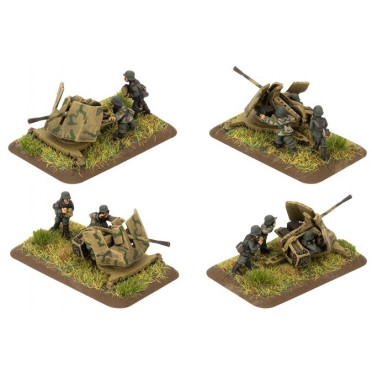Flames of War - 3.7cm AA Platoon
BAT-GE540
During the pre-war and early period of the war, medium anti-aircraft guns (3.7cm and 4cm calibres) were relegated to a relatively minor role in Germany’s air defence. Instead, emphasis was placed on the light 2cm calibre weapons such as the FlaK30, FlaK38 and Flakvierling 38 (quad 2cm).
As the Allies imposed their dominance in the skies the need for medium anti-aircraft weapons became greater. The 2cm weapons hitting power and range were not always up to the task, the 3.7cm weapons offered greater range and hitting power without a dramatic decrease in the rate of fire.
The original 3.7 cm Flugzeugabwehrkanone 18 gun was developed by Rheinmetall in 1935 and was essentially an enlarged version of the 2cm FlaK30.
Like the smaller weapon, it used a mechanical bolt for automatic fire and had a good rate of fire of about 160 RPM. The 3.7cm Flak18 was only produced in small numbers.
Development continued resulting in a lighter two-wheel mount produced as the 3.7cm Flak36. An improved sighting system introduced the following year produced the 3.7cm Flak37. Existing weapons were upgraded with the new sight. It was put back into production in 1942 and 1178 were made before production ended in 1944.
However, the Germans were not content with the 3.7cm FlaK37 gun. The design was modified to have a new gas-operated breech that improved its rate of fire to 250 RPM.
The new design also dropped its weight from 1544kg to 1247kg. Other changes were made to ease production. The result was the 3.7cm Flak43.
Although the weapon was completed in 1942, production did not start until 1944. 928 3.7cm FlaK43 guns were produced by end of the war.
The 3.7cm FlaK43 in its towed ground mount version was mostly issued to Luftwaffe anti-aircraft units. These Luftwaffe units, however, were often found supporting Heer units in the field.
Copyright © 2025 www.philibertnet.com Legals - Privacy Policy - Cookie Preferences - Sitemap





